The Multimessenger Contribution of Ultra-High-Energy Cosmic Rays from Gamma-Ray Bursts
Abstract
1. Introduction
2. Propagation with CRPROPA 3
3. Simulation Data Set
4. Result
4.1. Calculation of All-Sky Isotropic Emission
4.2. Hadronic Mutimessenger Contribution from HL GRBs
4.3. Hadronic Mutimessenger for the LL GRB Case
4.4. The Tightest Constraint from GeV Photons
4.5. The Robustness of the Analysis
5. Conclusions
Author Contributions
Funding
Data Availability Statement
Conflicts of Interest
References
- Milgrom, M.; Usov, V. Possible Association of Ultra-High-Energy Cosmic-Ray Events with Strong Gamma-Ray Bursts. Astrophys. J. 1995, 449, L37. [Google Scholar] [CrossRef]
- Vietri, M. The Acceleration of Ultra–High-Energy Cosmic Rays in Gamma-Ray Bursts. arXiv, 1995; arXiv:astro-ph/9506081. [Google Scholar]
- Waxman, E.; Bahcall, J. High Energy Neutrinos from Cosmological Gamma-Ray Burst Fireballs. Phys. Rev. Lett. 1997, 78, 2292–2295. [Google Scholar] [CrossRef]
- Halim, A.A.; Abreu, P.; Aglietta, M.; Allekotte, I.; Cheminant, K.A.; Almela, A.; Alvarez-Muñiz, J.; Yebra, J.A.; Anastasi, G.; Anchordoqui, L.; et al. Constraining the Sources of Ultra-High-Energy Cosmic Rays across and above the Ankle with the Spectrum and Composition Data Measured at the Pierre Auger Observatory. J. Cosmol. Astropart. Phys. 2023, 2023, 24. [Google Scholar] [CrossRef]
- Murase, K.; Ioka, K.; Nagataki, S.; Nakamura, T. High-Energy Cosmic-Ray Nuclei from High- and Low-Luminosity Gamma-Ray Bursts and Implications for Multimessenger Astronomy. Phys. Rev. D 2008, 78, 023005. [Google Scholar] [CrossRef]
- Zhang, B.T.; Murase, K.; Kimura, S.S.; Horiuchi, S.; Mészáros, P. Low-Luminosity Gamma-Ray Bursts as the Sources of Ultrahigh-Energy Cosmic Ray Nuclei. Phys. Rev. D 2018, 97, 083010. [Google Scholar] [CrossRef]
- Murase, K.; Fukugita, M. Energetics of High-Energy Cosmic Radiations. Phys. Rev. D 2019, 99, 063012. [Google Scholar] [CrossRef]
- Murase, K.; Guetta, D.; Ahlers, M. Hidden Cosmic-Ray Accelerators as an Origin of TeV-PeV Cosmic Neutrinos. Phys. Rev. Lett. 2016, 116, 071101. [Google Scholar] [CrossRef]
- Álvarez, E.; Cuoco, A.; Mirabal, N.; Zaharijas, G. Searches for Correlation between UHECR Events and High-Energy Gamma-Ray Fermi-LAT Data. J. Cosmol. Astropart. Phys. 2016, 2016, 023. [Google Scholar] [CrossRef]
- Abbasi, R.; Ackermann, M.; Adams, J.; Agarwalla, S.K.; Aguilar, J.A.; Ahlers, M.; Alameddine, J.M.; Amin, N.M.; Andeen, K.; Anton, G.; et al. Search for 10–1000 GeV Neutrinos from Gamma-Ray Bursts with IceCube. Astrophys. J. 2024, 964, 126. [Google Scholar] [CrossRef]
- Abbasi, R.; Ackermann, M.; Adams, J.; Agarwalla, S.K.; Aggarwal, N.; Aguilar, J.A.; Ahlers, M.; Alameddine, J.M.; Amin, N.M.; Andeen, K.; et al. Limits on Neutrino Emission from GRB 221009A from MeV to PeV Using the IceCube Neutrino Observatory. Astrophys. J. Lett. 2023, 946, L26. [Google Scholar] [CrossRef]
- Giannios, D. UHECRs from Magnetic Reconnection in Relativistic Jets. Mon. Not. R. Astron. Soc. Lett. 2010, 408, L46–L50. [Google Scholar] [CrossRef]
- Dermer, C.D.; Razzaque, S. Acceleration of Ultra-high-energy Cosmic Rays in the Colliding Shells of Blazars and Gamma-ray Bursts: Constraints from the Fermi Gamma-ray Space Telescope. Astrophys. J. 2010, 724, 1366. [Google Scholar] [CrossRef]
- Alves Batista, R.; Shin, M.S.; Devriendt, J.; Semikoz, D.; Sigl, G. Implications of Strong Intergalactic Magnetic Fields for Ultrahigh-Energy Cosmic-Ray Astronomy. Phys. Rev. D 2017, 96, 023010. [Google Scholar] [CrossRef]
- Batista, R.A.; Dundovic, A.; Erdmann, M.; Kampert, K.H.; Kuempel, D.; Müller, G.; Sigl, G.; van Vliet, A.; Walz, D.; Winchen, T. CRPropa 3—A Public Astrophysical Simulation Framework for Propagating Extraterrestrial Ultra-High Energy Particles. J. Cosmol. Astropart. Phys. 2016, 2016, 38. [Google Scholar] [CrossRef]
- Gilmore, R.C.; Somerville, R.S.; Primack, J.R.; Domínguez, A. Semi-Analytic Modelling of the Extragalactic Background Light and Consequences for Extragalactic Gamma-Ray Spectra. Mon. Not. R. Astron. Soc. 2012, 422, 3189–3207. [Google Scholar] [CrossRef]
- Protheroe, R.; Biermann, P. A New Estimate of the Extragalactic Radio Background and Implications for Ultra-High-Energy γ-ray Propagation. Astropart. Phys. 1996, 6, 45–54. [Google Scholar] [CrossRef]
- Das, S.; Gupta, N.; Razzaque, S. Ultrahigh-energy Cosmic-Ray Interactions as the Origin of Very High-energy γ-Rays from BL Lacertae Objects. Astrophys. J. 2020, 889, 149. [Google Scholar] [CrossRef]
- Das, S.; Razzaque, S. Ultrahigh-Energy Cosmic-Ray Signature in GRB 221009A. Astron. Astrophys. 2023, 670, L12. [Google Scholar] [CrossRef]
- Wanderman, D.; Piran, T. The Luminosity Function and the Rate of Swift’s Gamma-Ray Bursts. Mon. Not. R. Astron. Soc. 2010, 406, 1944–1958. [Google Scholar] [CrossRef]
- Yao, Y.H.; Chang, X.C.; Hu, H.B.; Pan, Y.B.; Zhang, H.M.; Li, H.Y.; Qiao, B.Q.; Kang, M.M.; Yang, C.W.; Liu, W.; et al. Contribution of High-energy GRB Emissions to the Spectrum of the Isotropic Diffuse γ-Ray Background. Astrophys. J. 2020, 901, 106. [Google Scholar] [CrossRef]
- Liang, E.; Zhang, B.; Virgili, F.; Dai, Z.G. Low-Luminosity Gamma-Ray Bursts as a Unique Population: Luminosity Function, Local Rate, and Beaming Factor. Astrophys. J. 2007, 662, 1111. [Google Scholar] [CrossRef]
- Porciani, C.; Madau, P. On the Association of Gamma-Ray Bursts with Massive Stars: Implications for Number Counts and Lensing Statistics. Astrophys. J. 2001, 548, 522. [Google Scholar] [CrossRef]
- Poolakkil, S.; Preece, R.; Fletcher, C.; Goldstein, A.; Bhat, P.N.; Bissaldi, E.; Briggs, M.S.; Burns, E.; Cleveland, W.H.; Giles, M.M.; et al. The Fermi-GBM Gamma-Ray Burst Spectral Catalog: 10 yr of Data. Astrophys. J. 2021, 913, 60. [Google Scholar] [CrossRef]
- Zhang, B.; Kumar, P. Model-Dependent High-Energy Neutrino Flux from Gamma-Ray Bursts. Phys. Rev. Lett. 2013, 110, 121101. [Google Scholar] [CrossRef] [PubMed]
- Ackermann, M.; Ajello, M.; Albert, A.; Atwood, W.B.; Baldini, L.; Ballet, J.; Barbiellini, G.; Bastieri, D.; Bechtol, K.; Bellazzini, R.; et al. The Spectrum of Isotropic Diffuse Gamma-Ray Emission Between 100 MeV and 820 GeV. Astrophys. J. 2015, 799, 86. [Google Scholar] [CrossRef]
- Aguilar, J.A.; Allison, P.; Beatty, J.J.; Bernhoff, H.; Besson, D.; Bingefors, N.; Botner, O.; Buitink, S.; Carter, K.; Clark, B.A.; et al. The IceCube Neutrino Observatory–Contributions to ICRC 2017 Part II: Properties of the Atmospheric and Astrophysical Neutrino Flux. arXiv 2017, arXiv:1710.01191. [Google Scholar]
- Qu, Y.; Zeng, H.; Yan, D. Gamma-ray Luminosity Function of BL Lac Objects and Contribution to the Extragalactic Gamma-Ray Background. Mon. Not. R. Astron. Soc. 2019, 490, 758–765. [Google Scholar] [CrossRef]
- Roth, M.A.; Krumholz, M.R.; Crocker, R.M.; Celli, S. The Diffuse γ-ray Background is Dominated by Star-Forming Galaxies. Nature 2021, 597, 341–344. [Google Scholar] [CrossRef] [PubMed]
- Aartsen, M.G.; Abraham, K.; Ackermann, M.; Adams, J.; Aguilar, J.A.; Ahlers, M.; Ahrens, M.; Altmann, D.; Anderson, T.; Archinger, M.; et al. A Combined Maximum-Likelihood Analysis of the High-Energy Astrophysical Neutrino Flux Measured with IceCube. Astrophys. J. 2015, 809, 98. [Google Scholar] [CrossRef]
- Liang, E.W.; Yi, S.X.; Zhang, J.; Lü, H.J.; Zhang, B.B.; Zhang, B. Constraining Gamma-ray Burst Initial Lorentz Factor with the Afterglow Onset Feature and Discovery of a Tight Γ0-E γ,iso Correlation. Astrophys. J. 2010, 725, 2209. [Google Scholar] [CrossRef]
- Galama, T.J.; Vreeswijk, P.M.; van Paradijs, J.; Kouveliotou, C.; Augusteijn, T.; Böhnhardt, H.; Brewer, J.P.; Doublier, V.; Gonzalez, J.F.; Leibundgut, B.; et al. An Unusual Supernova in the Error Box of the γ-ray Burst of 25 April 1998. Nature 1998, 395, 670–672. [Google Scholar] [CrossRef]
- Soderberg, A.M.; Nakar, E.; Berger, E.; Kulkarni, S.R. Late-Time Radio Observations of 68 Type Ibc Supernovae: Strong Constraints on Off-Axis Gamma-Ray Bursts. Astrophys. J. 2006, 638, 930. [Google Scholar] [CrossRef]
- Xu, D.; de Ugarte Postigo, A.; Leloudas, G.; Krühler, T.; Cano, Z.; Hjorth, J.; Malesani, D.; Fynbo, J.P.U.; Thöne, C.C.; Sánchez-Ramírez, R.; et al. Discovery of the Broad-Lined Type Ic SN 2013cq Associated with the very Energetic GRB 130427A. Astrophys. J. 2013, 776, 98. [Google Scholar] [CrossRef]
- Dereli, H.; Boër, M.; Gendre, B.; Amati, L.; Dichiara, S.; Orange, N.B. A Study of GRBs with Low-luminosity Afterglows. Astrophys. J. 2017, 850, 117. [Google Scholar] [CrossRef]
- Ohira, Y.; Murase, K.; Yamazaki, R. Escape-Limited Model of Cosmic-ray Acceleration Revisited. Astron. Astrophys. 2010, 513, A17. [Google Scholar] [CrossRef]
- Ackermann, M.; Ajello, M.; Asano, K.; Axelsson, M.; Baldini, L.; Ballet, J.; Barbiellini, G.; Bastieri, D.; Bechtol, K.; Bellazzini, R.; et al. The First Fermi-LAT Gamma-Ray Burst Catalog. Astrophys. J. Suppl. Ser. 2013, 209, 11. [Google Scholar] [CrossRef]
- Xia, Z.Q.; Wang, Y.; Yuan, Q.; Fan, Y.Z. A Delayed 400 GeV Photon from GRB 221009A and Implication on the Intergalactic Magnetic Field. Nat. Commun. 2024, 15, 4280. [Google Scholar] [CrossRef]
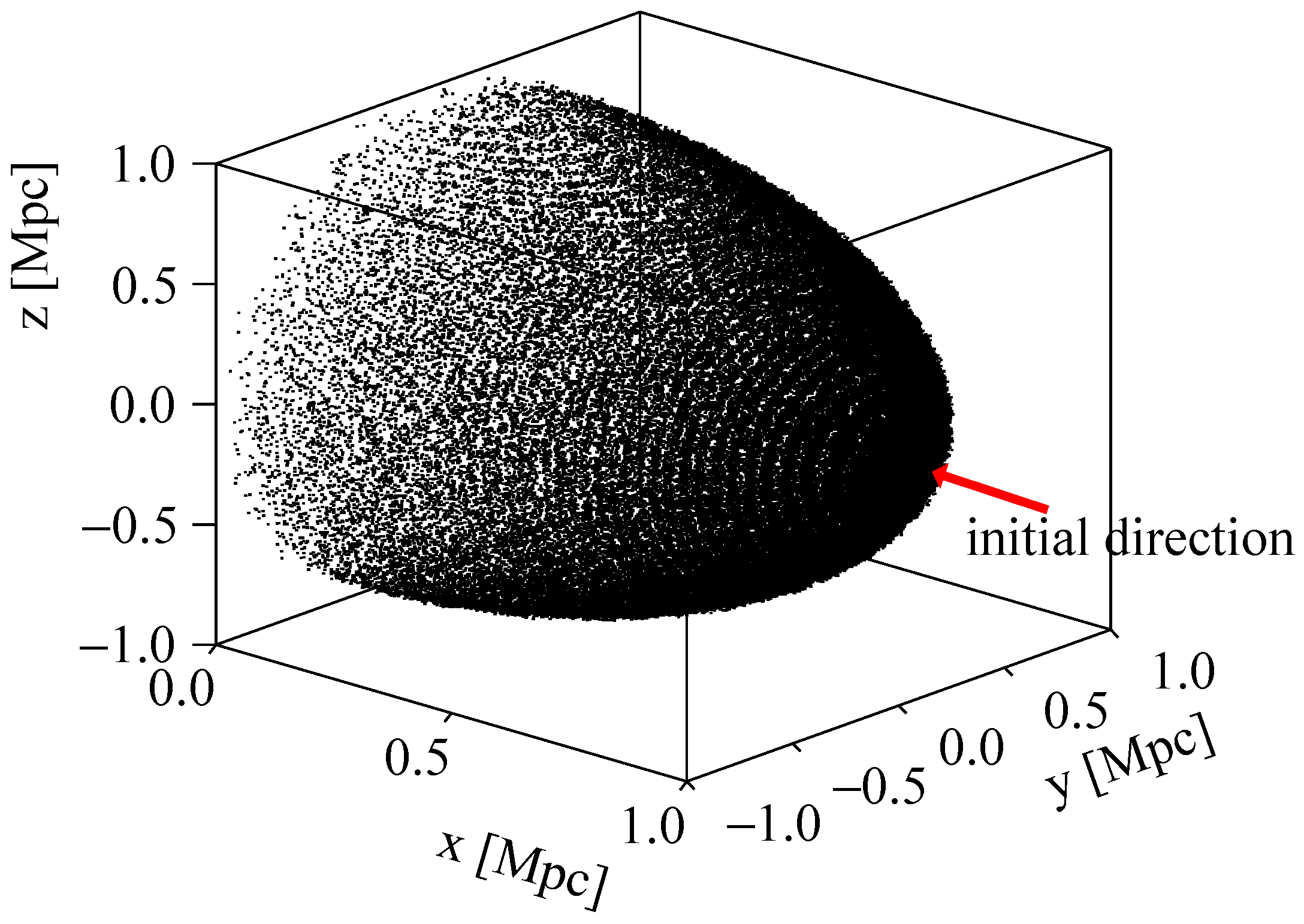
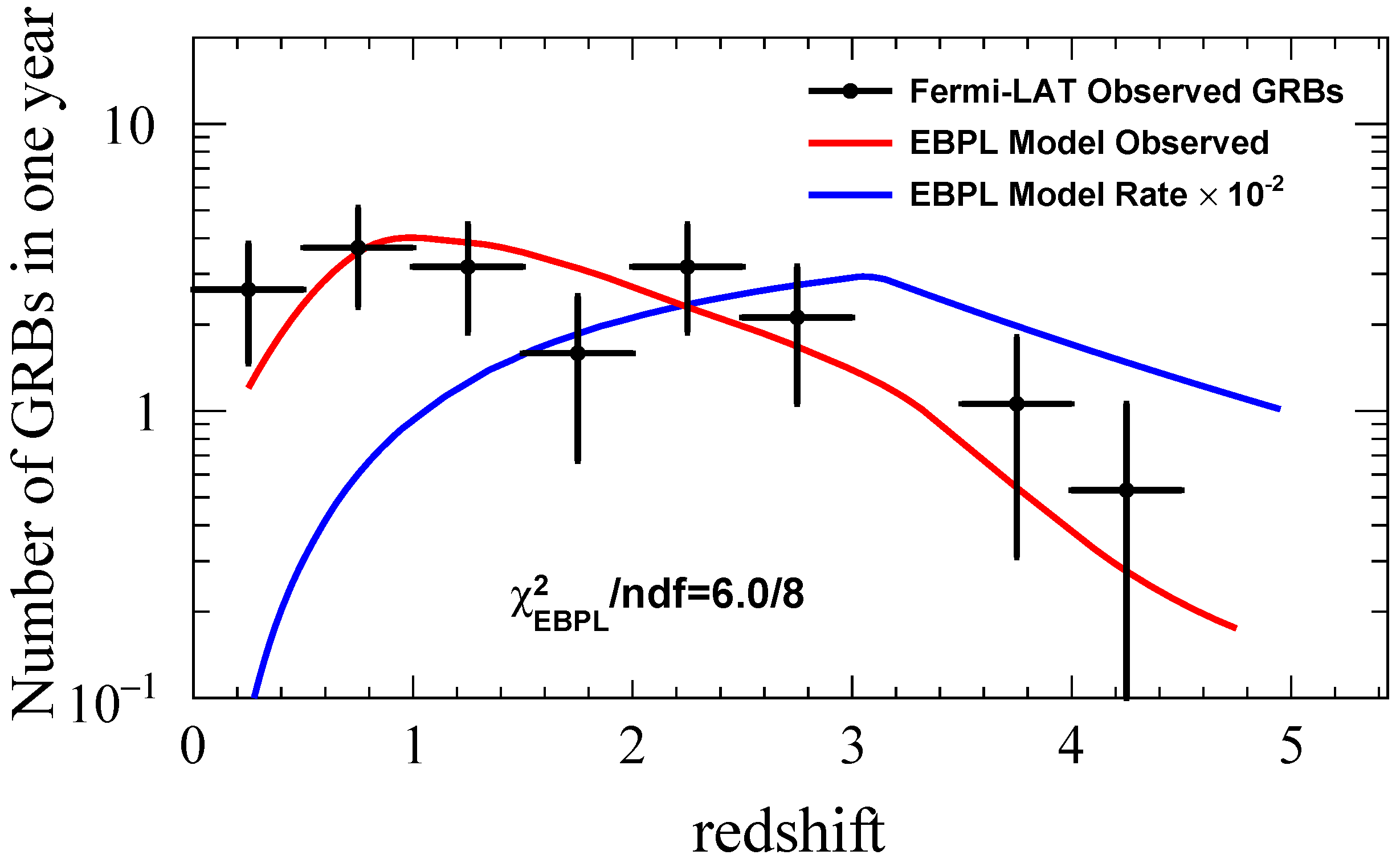
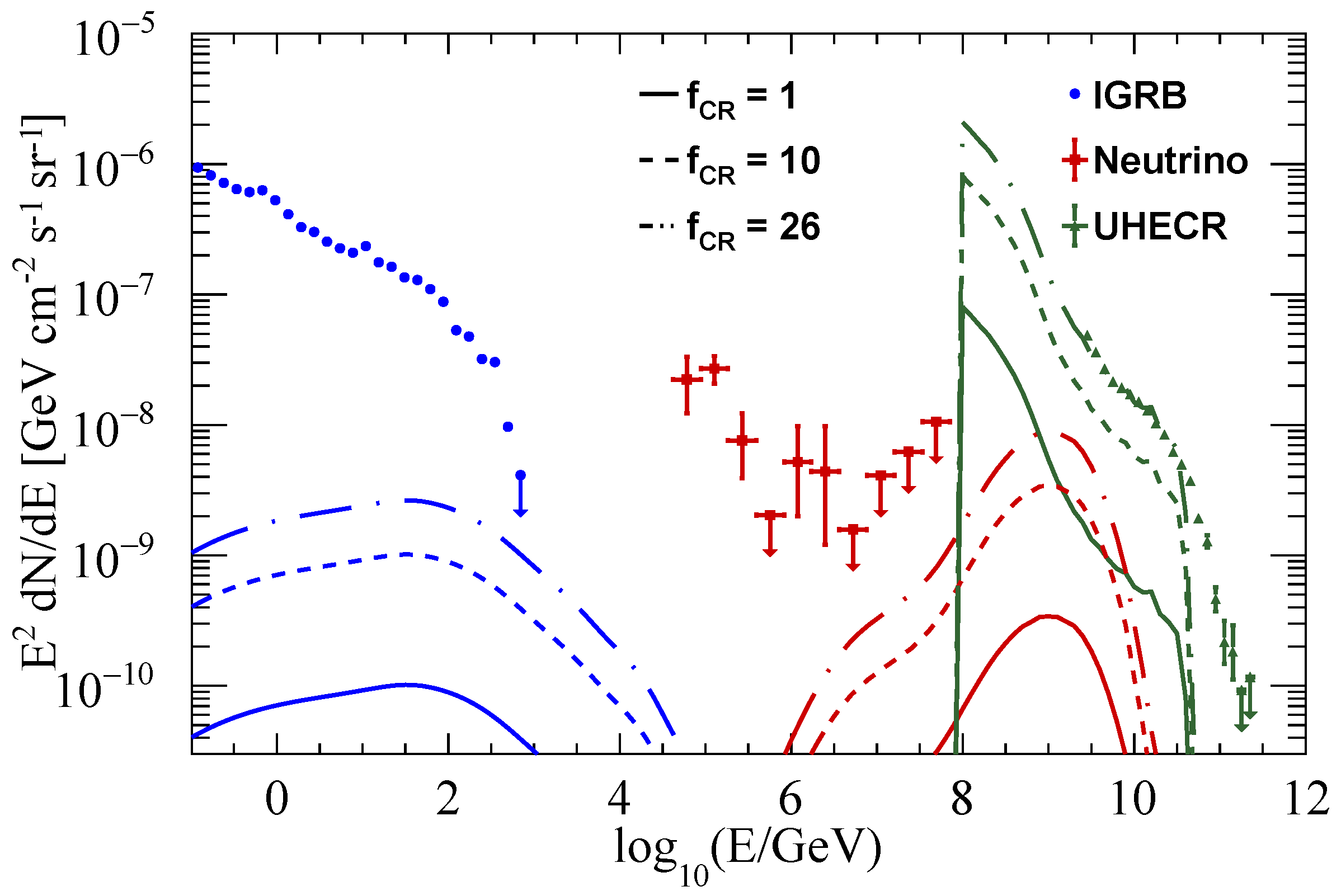
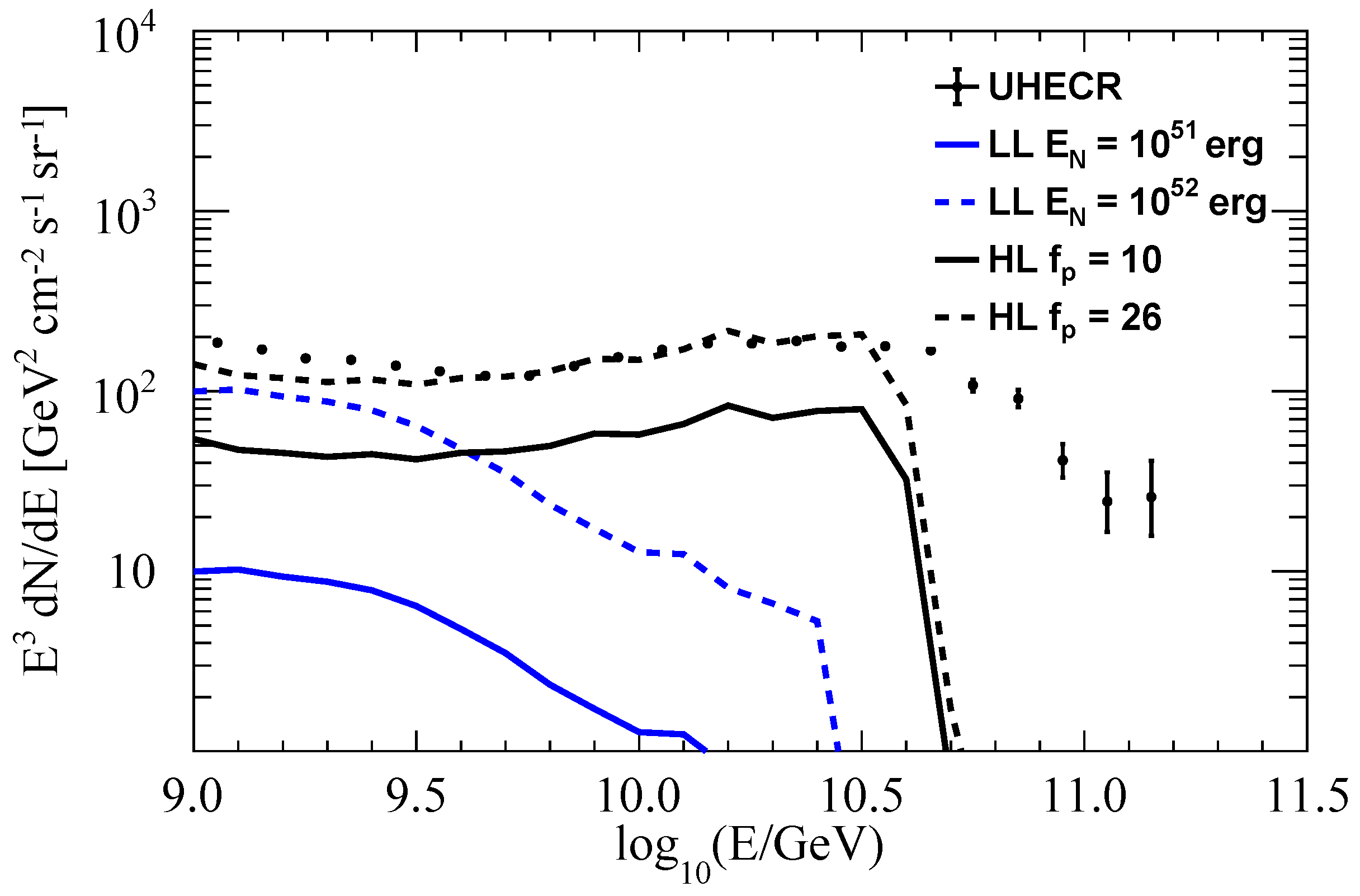
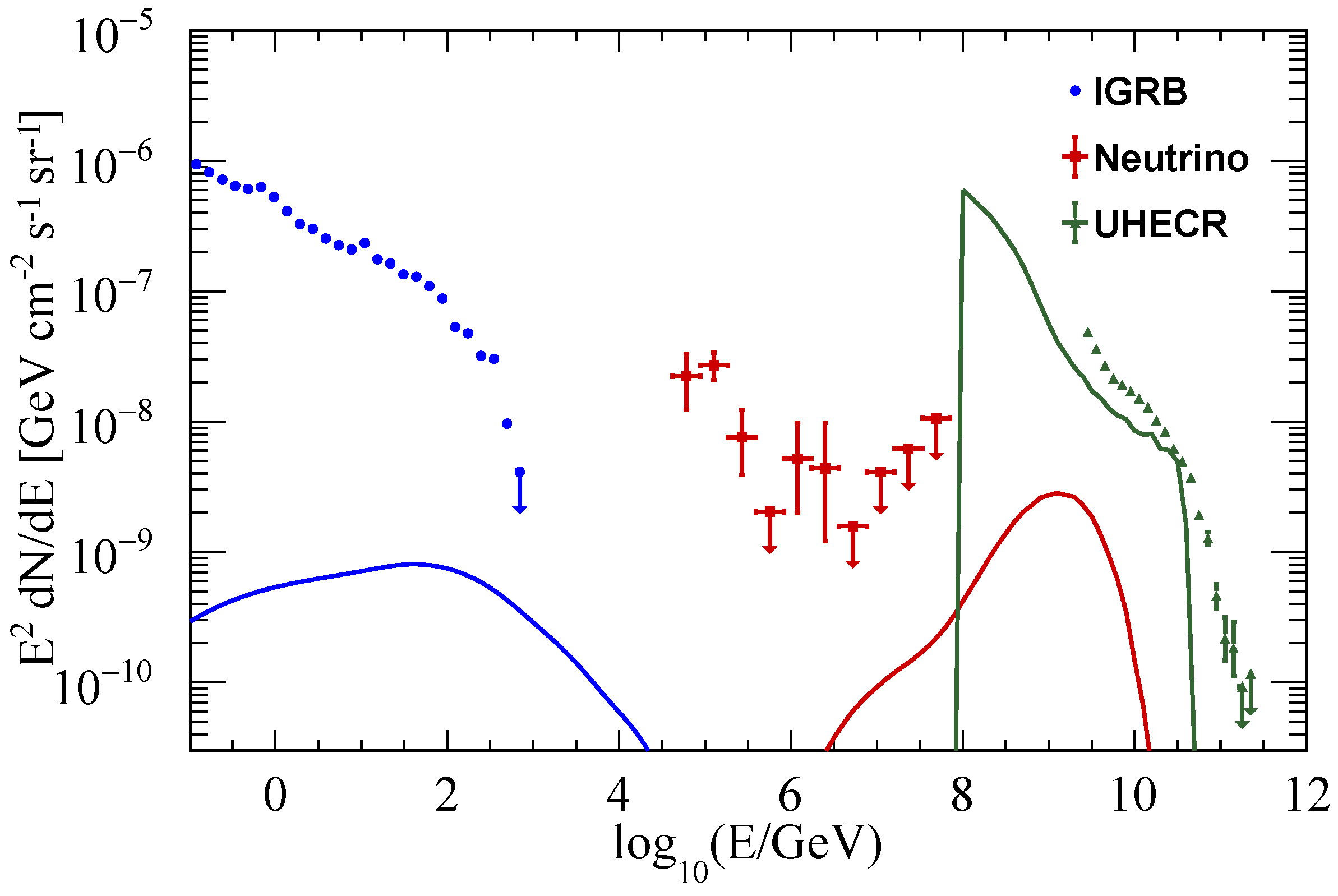
Disclaimer/Publisher’s Note: The statements, opinions and data contained in all publications are solely those of the individual author(s) and contributor(s) and not of MDPI and/or the editor(s). MDPI and/or the editor(s) disclaim responsibility for any injury to people or property resulting from any ideas, methods, instructions or products referred to in the content. |
© 2025 by the authors. Licensee MDPI, Basel, Switzerland. This article is an open access article distributed under the terms and conditions of the Creative Commons Attribution (CC BY) license (https://creativecommons.org/licenses/by/4.0/).
Share and Cite
Li, Z.; Min, F.; Jin, Y.; Guo, Y. The Multimessenger Contribution of Ultra-High-Energy Cosmic Rays from Gamma-Ray Bursts. Universe 2025, 11, 22. https://doi.org/10.3390/universe11010022
Li Z, Min F, Jin Y, Guo Y. The Multimessenger Contribution of Ultra-High-Energy Cosmic Rays from Gamma-Ray Bursts. Universe. 2025; 11(1):22. https://doi.org/10.3390/universe11010022
Chicago/Turabian StyleLi, Zhenjiang, Fangsheng Min, Yi Jin, and Yiqing Guo. 2025. "The Multimessenger Contribution of Ultra-High-Energy Cosmic Rays from Gamma-Ray Bursts" Universe 11, no. 1: 22. https://doi.org/10.3390/universe11010022
APA StyleLi, Z., Min, F., Jin, Y., & Guo, Y. (2025). The Multimessenger Contribution of Ultra-High-Energy Cosmic Rays from Gamma-Ray Bursts. Universe, 11(1), 22. https://doi.org/10.3390/universe11010022





